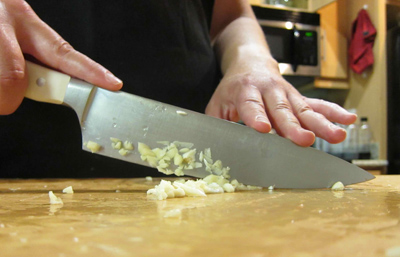Channeling my inner Dean Cliver, I had a chat last week with my friend Matt Shipman about cutting boards and food safety. Matt, a science writer, public information officer at North Carolina State University, curator of The Abstract, and all around swell dude, writes:
Anything that touches your food can be a source of contamination and foodborne illness – including cutting boards.
For example, if you cut up a raw chicken, and then use the same cutting board to slice a tomato for your salad, you run the risk of cross-contamination – with bacteria from the chicken being transferred to the tomato. That, of course, would be bad.
And vegetarians aren’t off the hook either. Fruits and vegetables can also carry pathogens (and transfer them to cutting boards).
To reduce the risk of foodborne illness in your kitchen, here are some things you should know about cutting boards.
Plastic Versus Wood
For a long time, most (if not all) cutting boards were made of wood. But at some point people began using plastic cutting boards. The idea was that they were easier to clean (and sanitize), and therefore were safer.
But in the late 1980s, a UC Davis researcher named Dean Cliver – the de facto godfather of cutting board food safety – decided to investigate whether plastic cutting boards really were safer. Answer: not really.

Plastic cutting boards, Cliver found, are easier to sanitize. But cutting on them also leaves lots of grooves where bacteria can hide. Wood is tougher to sanitize, but it’s also (often) tougher in general – you won’t find as many deep scratches in the surface.
In addition, researchers have discovered that the type of wood your cutting board is made from also makes a difference.
“Hardwoods, like maple, are fine-grained, and the capillary action of those grains pulls down fluid, trapping the bacteria – which are killed off as the board dries after cleaning,” says Ben Chapman, a food safety researcher at NC State. “Soft woods, like cypress, are less likely to dull the edge of your knife, but also pose a greater food safety risk,” Chapman explains. “That’s because they have larger grains, which allows the wood to split apart more easily, forming grooves where bacteria can thrive.”
Which type of cutting board should you use? Chapman recommends using plastic cutting boards for meat and wood cutting boards for fruit, vegetables, or any ready-to-eat foods (like bread or cheese).
Why use plastic cutting boards for meat? Because of how you wash them.
Cleaning Your Cutting Board
Plastic and wood have different characteristics, so you have to handle them differently.
Plastic cutting boards can be placed in the dishwasher, where they can be sanitized by washing at high temperatures. But wood cutting boards would quickly be ruined by a dishwasher, and not everyone owns a dishwasher. If you’re washing a cutting board by hand, you should:
- Rinse the debris off the cutting board (being careful not to splatter contaminated water all over the place);
- Scrub the cutting board with soap and water (to get out anything in the scratches or grooves on the board’s surface); and
- Sanitize the cutting board (you should use different sanitizers for wood cutting boards than for plastic ones).
For plastic cutting boards, you should use a chlorine-based sanitizer, such as a solution of bleach and water (one tablespoon of bleach per gallon of water – has a shelf life of a week or two). But for wood cutting boards, you should use a quaternary ammonia sanitizer, such as a solution of Mr. Clean and water (follow the dilution instructions on the label).
“This is because chlorine binds very easily to organic materials, like the wood in a cutting board, which neutralizes its antibacterial properties,” Chapman says. “Quaternary ammonia is more effective at killing bacteria on wood or other organic surfaces.”
It’s worth noting that you should also sanitize your kitchen sponge/rag/brush after you’ve used it to scrub the chicken-juice off your cutting board – or else you run the risk of contaminating the next thing you wash (which is the exact opposite of what you’re trying to do).
The last step in cleaning your cutting board is an important one –dry it.
“Make sure you put the cutting board somewhere that air circulates, so that it can dry completely,” Chapman says. Bacteria need moisture to grow, and you don’t want to give them a welcoming environment.
“Historically, butchers used to put salt on their butcher blocks to keep them from smelling bad,” Chapman says. “This worked because the salt drew the moisture out of the wood and prevented bacterial contamination, which is what caused the smell – though the butchers didn’t know it at the time.”
When To Replace Your Cutting Board
At some point, scrubbing and sanitizing might not be enough. When your cutting board has accumulated a lot of deep grooves from repeated use, you probably need to replace it.
“The more grooves it has, and the bigger they are, the more area is available for trapping moisture and giving bacteria a place to proliferate,” Chapman says.



